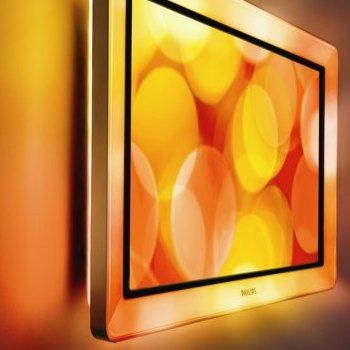I know what you are thinking? There is no way I am putting something that looks like a fairground ride in my living room. People will mock me. They will say I'm more interested in gimmicks than technology. But should you stand your ground with the new Philips Aurea LCD television? We get viewing to find out.
Our quick take
When I first saw the Aurea under trade stand conditions at IFA in Berlin, Germany, last year I have to admit I wondered who on earth would want something like that in their living room.
Having lived with the television for the last 2 weeks in my living room the experience is not only not bad, but quite enjoyable.
Light flows around the TV making the picture appear bigger and the changes of colour according to the picture work effortlessly, it's very impressive watching high contrasting images.
Would we have one in our living room? We've got the thumbs up from Mrs Pocket-lint, the only catch is finding the £3000 it costs to buy one.

Philips Aurea LCD television - 4.5 / 5
| FOR | AGAINST |
|---|---|
|
|
The Philips Aurea takes the Ambilight technology one stage further and instead of having light that changes according to the picture thrown out the back of the television, Philips has made the frame translucent and thrown it out the front.
Coming in a 42-inch screen size the laminated frame makes the overall television akin to a 47-inch model and it's something to bear in mind when you measure the space it's going to go in.
The result of all this light is that the area surrounding the television (preferably a white wall) is bathed in it. Light that is interactive, light that changes according to the picture, light that won't strain your eyes.
With numerous settings so you can change everything from the intensity of colour to the intensity of the light and pretty much anything else you can think of, it's not as offensive as you might imagine.
In fact, Mrs Pocket-lint (lets face it, the person you need to convince the most) in our home test was positively enthusiastic about it all.
"Oh, I like that", she was heard saying.
Over the course of watching television for a week, the glaring lightshow soon pales into the background and the best way to describe it is a bit like a subwoofer; you'll notice it at first but soon get used to it. Turn it off however and you'll realise its gone.
But the Ambilight element is not the only thing you'll notice about Philips' flagship LCD television. The picture is stunning.
Thanks to a number of technologies from Philips, that you can turn on or off just to prove to yourself that they are working, the picture quality is impressive.
The set offers 1080p support and the company's Perfect Pixel HD Engine as well as operating at 100Hz with a 3ms response time for an enhanced viewing experience removing blurry images in real time.
Sound-wise and the Aurea features an "invisible" sound system which is fully integrated into the rim of the Aurea. It uses 2 arrays of 12 invisible firing front drivers and, 2 subwoofer/mid speaker boxes in the bottom of the TV combined for 26 speakers.
Eitherway they all work to make the picture better regardless of the source.
Admittedly source does have a lot to do with (no amount of technology helps improve EastEnders) but once again the big cheese of the living room, Mrs Pocket-lint, noted that the picture was considerably better than our 2-year-old Samsung model, and this, without sounding too condescending, comes from someone who struggles to see the difference between HD and SD footage when you jump between channels on Sky HD.
For the more technical out there, the Philips Aurea offers all the relevant outputs including three HMDI, all of which can have their settings altered accordingly.
Although there isn't a gaming mode as yet (promised for later in the year) it will allow you to set up connections for more gaming-friendly options than, say, your DVD player.
Grumbles? Well I have noticed some halo effects around people's heads as presumably the technologies try and do the best to clean the image, but this is infrequent and something that you'll notice now and then if you look out for it rather than something that hinders every frame.
Likewise due to the way the technology works (the frame is translucent remember) the frame is never black with light seeping around it.
Finally out of the box and the factory default settings for all this tech, lights and audio are a bit much. It's worth refining it before you get started.
To recap
Would we have one in our living room? We've got the thumbs up from Mrs Pocket-lint, the only catch is finding the £3000 it costs to buy one
